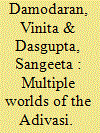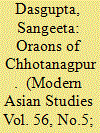|
|
|
Sort Order |
|
|
|
Items / Page
|
|
|
|
|
|
|
| Srl | Item |
| 1 |
ID:
144224


|
|
|
|
|
| Summary/Abstract |
Through a description of the interactions of Christian missionaries in Chhotanagpur with the Oraons, this article illustrates the different ways in which the missionaries grappled with and restructured their notions of the ‘tribe’ and the ‘Oraon’ across the nineteenth and early twentieth centuries. The Oraon, I argue, was initially recognized in terms of his heathen practices, his so-called compact with the Devil, and his world of idolatry and demonology. But, by the end of the nineteenth century, he increasingly became, in missionary language, an animistic aboriginal tribe, a ‘primitive’ within an evolutionary schema. As the missionaries searched for an authentic Oraon language, for myths, traditions and histories, an array of categories—heathen, savage, race, tribe, and aboriginal—seemingly jostled with one another in their narratives. Indeed, the tension between religion and race could never be resolved in missionary narratives; this was reflected in colonial ethnographic literature that drew upon and yet eventually marginalized missionary representations. I conclude by referring to a case in the 1960s filed by Kartik Oraon against the Protestant convert David Munzni before the Election Tribunal at Ranchi, which was ultimately resolved in the Supreme Court, that raised the question whether religion or race determined tribal identity.
|
|
|
|
|
|
|
|
|
|
|
|
|
|
|
|
| 2 |
ID:
187279


|
|
|
|
|
| Summary/Abstract |
On 6 December 1959, the image of Indian Prime Minister Jawaharlal Nehru inaugurating the Damodar Valley Corporation dam project in Bihar with a 15-year-old Adivasi girl called Budhini Manjhiyan was flashed across the national newspapers. This was an iconic moment in the national debate around development and change which was to dominate modern India on whether lands, predominately rural and tribal, were to be flooded to benefit the nation. Years later, in 2016, when the newspapers caught up with Budhini, she had returned to Jharkhand and was struggling to make ends meet for herself and her children. Her story resonates with the ways in which, in recent times, Adivasis are becoming increasingly visible as subjects in debates around indigeneity, identity, conversion, development, and climate change. The post-colonial Indian state and its allies, with a developmentalist agenda uppermost in their minds, have made loss of land, displacement, migration, and forced resettlement a part of Adivasi experiences. Forces of globalization, often in tandem with the policies of the Indian state, are engulfing marginal spaces. The increasingly powerful majoritarian narrative of the state subsumes alternate voices with easy nonchalance. The foregrounding of planetary narratives on the fate of humanity in the era of the Anthropocene erases the importance of particular locales and specific communities that could offer an alternative to declensionist narratives. But amid this marginalization, there also lies a story of the assertion of Adivasi agency. Voices of Adivasis—although multiple and fractured—can be heard as they assert their identity, express their politics, and creatively negotiate with the state and its institutions. Scattered across India in geographically differentiated terrains, pursuing different occupations, and speaking different languages, the experiences of Adivasis are varied, as they inhabit many worlds. Their stories point to the multiplicity of cultures and myriad ways of thinking that must be accommodated within the ambit of the nation, and yet offer the possibilities of different ways of living and being on this earth.
|
|
|
|
|
|
|
|
|
|
|
|
|
|
|
|
| 3 |
ID:
187280


|
|
|
|
|
| Summary/Abstract |
This article explores nineteenth-century colonial representations of the Oraons of Chhotanagpur. Described in administrative reports of early nineteenth-century Chhotanagpur as mlecchha and dhangar, or as part of a ‘village community’ of Coles/Kols, these Oraons, by the late nineteenth century, were referred to as a ‘tribe’. To trace the categories through which the Oraons journeyed across colonial records, I discuss texts and reports which later became part of bureaucratic memory. The shifts within official understanding, I argue, were related to the working of official minds, changing assumptions, and differing languages; the tensions within the discipline of anthropology and its application in the colony; the variations within ideologies of governance and the imperatives of rule; and interactions with ‘native’ informants and correspondents, along with personal observations of local practices. There remained, however, an uneasy tension between wider intellectual trends in Europe and their reverberations in the colony, and the experiences of governance: colonial knowledge was not always produced with arrogance and assurance but also with doses of uncertainty, hesitation, disquiet, and often despair. In the shifting representations of the tribe across the nineteenth century, there is, I suggest, a pattern. In the pre-1850s, local nomenclature was adopted and voices of dissent—expressed through agrarian protests in Chhotanagpur—were addressed. By the 1850s, the utilitarian agenda structured colonial imaginaries and interventions. The 1860s witnessed the interplay of ethnological concerns, missionary beliefs, and Arcadian principles. From the 1890s, the idea of tribe was overwhelmingly structured by the supremacy of disciplinary knowledge systems that increasingly supplanted the role of the ‘native’ informant.
|
|
|
|
|
|
|
|
|
|
|
|
|
|
|
|
|
|
|
|
|